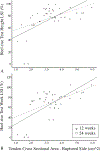Achilles tendon cross-sectional area at 12 weeks post-rupture relates to 1-year heel-rise height
- PMID: 31267192
- PMCID: PMC6939153
- DOI: 10.1007/s00167-019-05608-x
Achilles tendon cross-sectional area at 12 weeks post-rupture relates to 1-year heel-rise height
Abstract
Purpose: Achilles tendon rupture leads to long-term plantar flexor deficits, but some patients recover functional performance better than others. Early indicators of tendon healing could be helpful in establishing patient prognosis and making individualized decisions regarding rehabilitation progression. The purpose of this study was to investigate relationships between early tendon morphology and mechanical properties to long-term heel-rise and jumping function in individuals after Achilles tendon rupture.
Methods: Individuals after Achilles tendon rupture were assessed at 4, 8, 12, 24, and 52 weeks post-injury. Tendon cross-sectional area, length, and mechanical properties were measured using ultrasound. Heel-rise and jump tests were performed at 24 and 52 weeks. Correlation and regression analysis were used to identify relationships between tendon structural variables in the first 12 weeks to functional outcomes at 52 weeks, and determine whether the addition of tendon structural characteristics at 24 weeks strengthened relationships between functional performance at 24 and 52 weeks. Functional outcomes of individuals with < 3 cm of elongation were compared to those with > 3 cm of elongation using a Mann-Whitney U test.
Results: Twenty-two participants [mean (SD) age = 40 (11) years, 17 male] were included. Tendon cross-sectional area at 12 weeks was the strongest predictor of heel-rise height (R2 = 0.280, p = 0.014) and work symmetry (R2 = 0.316, p = 0.008) at 52 weeks. Jumping performance at 52 weeks was not significantly related to any of the tendon structural measures in the first 12 weeks. Performance of all functional tasks at 24 weeks was positively related to performance on the same task at 52 weeks (r = 0.456-0.708, p < 0.05). The addition of tendon cross-sectional area improved the model for height LSI (R2 = 0.519, p = 0.001). Tendon elongation > 3 cm significantly reduced jumping symmetry (p < 0.05).
Conclusion: Tendon cross-sectional area and excessive elongation related to plantar flexor performance on functional testing after Achilles tendon rupture. Once an individual is able to perform function-based testing, tendon structural measures may inform long-term prognosis. Ultrasound-based measures of tendon structure early in recovery seem to relate to later performance on functional testing. Clinically, assessing tendon structure has the potential to be used as a biomarker of tendon healing early in recovery and better predict patients at risk of negative functional outcome.
Level of evidence: II.
Keywords: Ankle; Morphology; Ultrasound; Viscoelastic properties.
Figures


Similar articles
-
Heel-Rise Height Deficit 1 Year After Achilles Tendon Rupture Relates to Changes in Ankle Biomechanics 6 Years After Injury.Am J Sports Med. 2017 Nov;45(13):3060-3068. doi: 10.1177/0363546517717698. Epub 2017 Aug 7. Am J Sports Med. 2017. PMID: 28783473
-
Tendon morphology and mechanical properties assessed by ultrasound show change early in recovery and potential prognostic ability for 6-month outcomes.Knee Surg Sports Traumatol Arthrosc. 2019 Sep;27(9):2831-2839. doi: 10.1007/s00167-018-5277-8. Epub 2018 Nov 10. Knee Surg Sports Traumatol Arthrosc. 2019. PMID: 30415387 Free PMC article.
-
Deficits in heel-rise height and achilles tendon elongation occur in patients recovering from an Achilles tendon rupture.Am J Sports Med. 2012 Jul;40(7):1564-71. doi: 10.1177/0363546512447926. Epub 2012 May 16. Am J Sports Med. 2012. PMID: 22593092
-
Achilles tendon rupture; assessment of nonoperative treatment.Dan Med J. 2014 Apr;61(4):B4837. Dan Med J. 2014. PMID: 24814601 Review.
-
Achilles tendon elongation after acute rupture: is it a problem? A systematic review.Knee Surg Sports Traumatol Arthrosc. 2020 Dec;28(12):4011-4030. doi: 10.1007/s00167-020-06010-8. Epub 2020 May 3. Knee Surg Sports Traumatol Arthrosc. 2020. PMID: 32363475
Cited by
-
Case study: The influence of Achilles tendon rupture on knee joint stress during counter-movement jump - Combining musculoskeletal modeling and finite element analysis.Heliyon. 2023 Jul 18;9(8):e18410. doi: 10.1016/j.heliyon.2023.e18410. eCollection 2023 Aug. Heliyon. 2023. PMID: 37560628 Free PMC article.
-
Persistent Deficits after an Achilles Tendon Rupture: A Narrative Review.Transl Sports Med. 2022 Jul 16;2022:7445398. doi: 10.1155/2022/7445398. eCollection 2022. Transl Sports Med. 2022. PMID: 38655161 Free PMC article. Review.
-
Is There a Relationship between the Morphology of Connective Tissue and Reactivity during a Drop Jump? Influence of Sex and Athletic Performance Level.Int J Environ Res Public Health. 2021 Feb 18;18(4):1969. doi: 10.3390/ijerph18041969. Int J Environ Res Public Health. 2021. PMID: 33670566 Free PMC article.
-
The release of adhesions improves outcome following minimally invasive repair of Achilles tendon rupture.Knee Surg Sports Traumatol Arthrosc. 2022 Mar;30(3):1109-1117. doi: 10.1007/s00167-021-06767-6. Epub 2021 Oct 18. Knee Surg Sports Traumatol Arthrosc. 2022. PMID: 34657973 Free PMC article.
-
Early Tendon Morphology as a Biomarker of Long-term Patient Outcomes After Surgical Repair of Achilles Tendon Rupture: A Prospective Cohort Study.Orthop J Sports Med. 2023 Nov 6;11(11):23259671231205326. doi: 10.1177/23259671231205326. eCollection 2023 Nov. Orthop J Sports Med. 2023. PMID: 37941888 Free PMC article.
References
-
- Aujla R, Patel S, Jones A, Bhatia M (2018) Predictors of functional outcome in non-operatively managed Achilles tendon ruptures. Foot Ankle Surg 24:336–341 - PubMed
-
- Baxter JR, Hullfish TJ, Chao W (2018) Functional deficits may be explained by plantarflexor remodeling following Achilles tendon rupture repair: Preliminary findings. J Biomech 79:238–242 - PubMed
-
- Brorsson A, Olsson N, Nilsson-Helander K, Karlsson J, Eriksson BI, Silbernagel KG (2015) Recovery of calf muscle endurance 3 months after an Achilles tendon rupture. Scand J Med Sci Sports 26:844–853 - PubMed
-
- Brorsson A, Silbernagel KG, Olsson N, Helander KN (2017) Calf muscle performance deficits remain 7 years after an Achilles tendon rupture. Am J Sports Med 46:470–477 - PubMed
-
- Brorsson A, Willy RW, Tranberg R, Grävare Silbernagel K (2017) Heel-rise height deficit 1 year after Achilles tendon rupture relates to changes in ankle biomechanics 6 years after injury. Am J Sports Med 45:3060–3068 - PubMed
MeSH terms
Grants and funding
LinkOut - more resources
Full Text Sources
Research Materials

